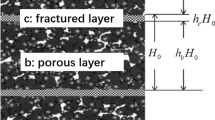Abstract
According to the Chapman multi-scale rock physical model, the seismic response characteristics vary for different fluid-saturated reservoirs. For class I AVO reservoirs and gas-saturation, the seismic response is a high-frequency bright spot as the amplitude energy shifts. However, it is a low-frequency shadow for the Class III AVO reservoirs saturated with hydrocarbons. In this paper, we verified the high-frequency bright spot results of Chapman for the Class I AVO response using the frequency-dependent analysis of a physical model dataset. The physical model is designed as inter-bedded thin sand and shale based on real field geology parameters. We observed two datasets using fixed offset and 2D geometry with different fluidsaturated conditions. Spectral and time-frequency analyses methods are applied to the seismic datasets to describe the response characteristics for gas-, water-, and oil-saturation. The results of physical model dataset processing and analysis indicate that reflection wave tuning and fluid-related dispersion are the main seismic response characteristic mechanisms. Additionally, the gas saturation model can be distinguished from water and oil saturation for Class I AVO utilizing the frequency-dependent abnormal characteristic. The frequency-dependent characteristic analysis of the physical model dataset verified the different spectral response characteristics corresponding to the different fluid-saturated models. Therefore, by careful analysis of real field seismic data, we can obtain the abnormal spectral characteristics induced by the fluid variation and implement fluid detection using seismic data directly.
Similar content being viewed by others
References
Aki, K., and Richards, P. G., 1980, Quantitative seismology: W. H. Freeman & Co.
Biot, M. A., 1956a, Theory of propagation of elastic waves in a fluid saturated porous solid — I: low frequency range: J. Acoust. Soc. Am., 28, 168–178.
Biot, M. A., 1956b, Theory of propagation of elastic waves in a fluid saturated porous solid — II: high frequency range: J. Acoust. Soc. Am., 28, 179–191.
Biot, M. A., 1962, Generalized theory of acoustic propagation in porous dissipative media: J. Acoust. Soc. Am., 34, 1254–1264.
Castagna, J. P., 1993, Petrophysical imaging using AVO: The Leading Edge, 12, 172–178.
Castagna, J. P., Sun, S. and Seigfried, R.W., 2003, Instantaneous spectral analysis: Detection of lowfrequency shadows associated with hydrocarbons: The Leading Edge, 22, 120–127.
Chapman, M., Zatsepin, S. V., and Crampin, S., 2002, Derivation of a microstructural poroelasticity model: Geophys. J. Int., 151, 427–451.
Chapman, M., 2003, Frequency dependent anisotropy due to meso-scale fractures in the presence of equant porosity: Geophysical Prospecting, 51, 369–379.
Chapman, M., Liu, E., and Li, X. Y., 2005, The influence of abnormally high reservoir attenuation on the AVO signature: The Leading Edge, 24, 1120–1125.
Chapman, M., Liu, E., and Li, X. Y., 2006, The influence of fluid-sensitive dispersion and attenuation on AVO analysis: Geophys. J. Int., 167, 89–105.
Ebrom, D., 2004, The low-frequency gas shadow on seismic sections: The Leading Edge, 23, 772.
Gassmann, F., 1951, Über die Elastizität poroser Medien: Veirteljahrsschrift der Naturforschenden Gesellschaft in Zürich, 96, 1–23.
Goloshubin, G., and Schuyver, C. V., 2006, Reservoir imaging using low frequencies of seismic reflections: The Leading Edge, 25, 527–531.
Kan, T. K., Batzle, M. L., and Gaiser, J. E., 1983, Attenuation measured from VSP: Evidence of frequencydependent Q: 53rd Ann. Internat. Mtg., Soc. Explor. Geophys., Expanded Abstracts, 589–590.
Korneev, V., Goloshubin, G., Daley, T., and Silin, D., 2004, Seismic low-frequency effects in monitoring fluidsaturated reservoirs: Geophysics, 69, 522–532.
Liu, E., and Chapman, M., 2006, Comparison of spectral decomposition techniques for evaluating frequencydependent variations in seismic data: Edinburgh Anisotropy Project Annual Report, Section C: Frequencydependent anisotropy.
Mavko, G., and Nur, A., 1975, Melt squirt in the asthenosphere: J. Geophys. Res., 80, 1444–1448.
Murphy, W. F., 1984, Acoustic measures of partial gas saturation in tight sandstones: J. Geophys. Res., 89, 11549–11559.
Odebeatu, E., Zhang, J., Chapman, M., Liu, E., and Li, X. Y., 2006, Application of spectral decomposition to detection of dispersion anomalies associated with gas saturation: The Leading Edge, 25, 206–210.
Partyka, G., Gridley, J., and Lopez, J., 1999, Interpretational applications of spectral decomposition in reservoir characterization: The Leading Edge, 18, 353–360.
Swan, H., 1991, Amplitude-versus-offset measurement errors in a finely layered medium: Geophysics, 56, 41–49.
Taner, M. T., Koehler, F., and Sheriff, R. E., 1979, Complex seismic trace analysis: Geophysics, 44, 1041–1063.
Wu, X., and Liu, T., 2009, Time-frequency analysis on Wigner-Ville distribution of seismic signal based on time-frequency rearrangement: Oil Geophysical Prospecting, 44(2), 201–205.
Zhao, B., Johnston, D., and Gouvela, W., 2006, Spectral decomposition of 4D seismic data: 76th Ann. Internat. Mtg., Soc. Expl. Geophys., Expanded Abstracts, 3235–3239.
Author information
Authors and Affiliations
Corresponding author
Additional information
This work is also partially supported by the National Science and Technology Major Project (No. 2011ZX05019-008), the National Natural Science Foundation of China (No. 41074080), and the Science Foundation of China University of Petroleum, Beijing (No. KYJJ2012-05-11).
Dr. Chen Shuang-Quan. PhD, Research fellow in China University of Petroleum, Beijing. He is mainly engaged in seismic data processing and inversion, multi-component seismic and seismic anisotropy.
Rights and permissions
About this article
Cite this article
Chen, SQ., Li, XY. & Wang, SX. The analysis of frequency-dependent characteristics for fluid detection: a physical model experiment. Appl. Geophys. 9, 195–206 (2012). https://doi.org/10.1007/s11770-012-0330-8
Received:
Revised:
Published:
Issue Date:
DOI: https://doi.org/10.1007/s11770-012-0330-8




